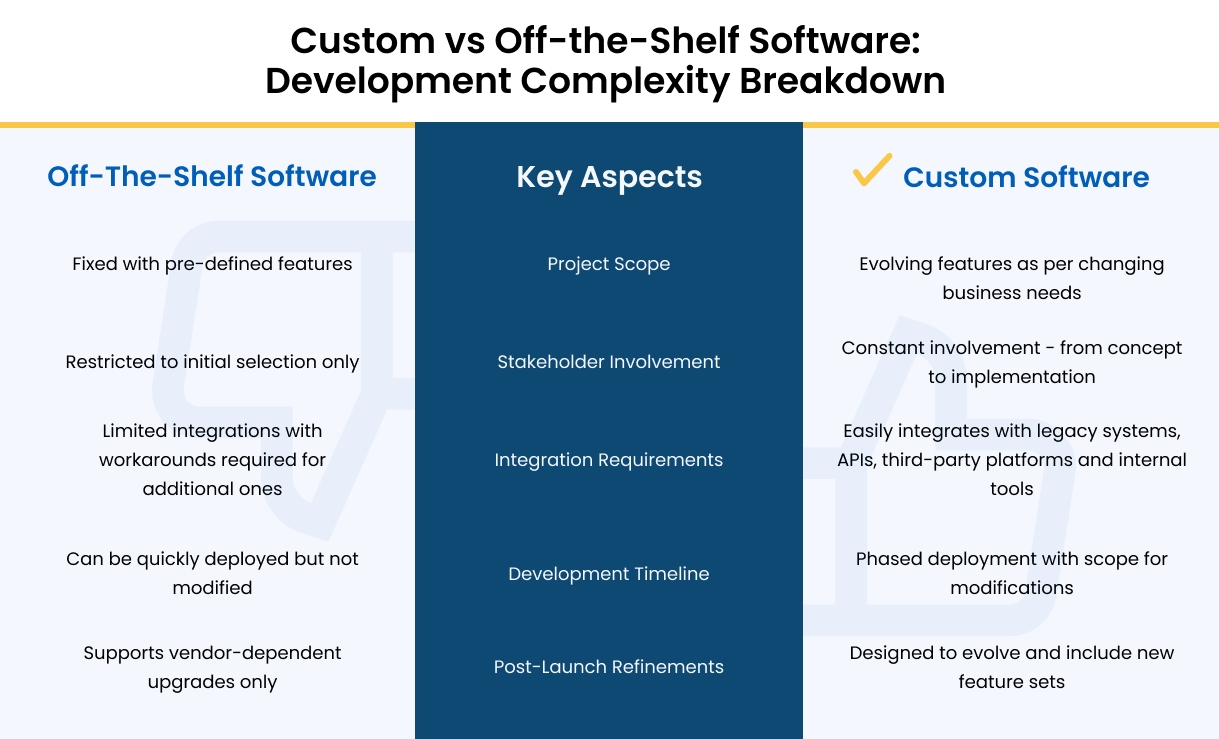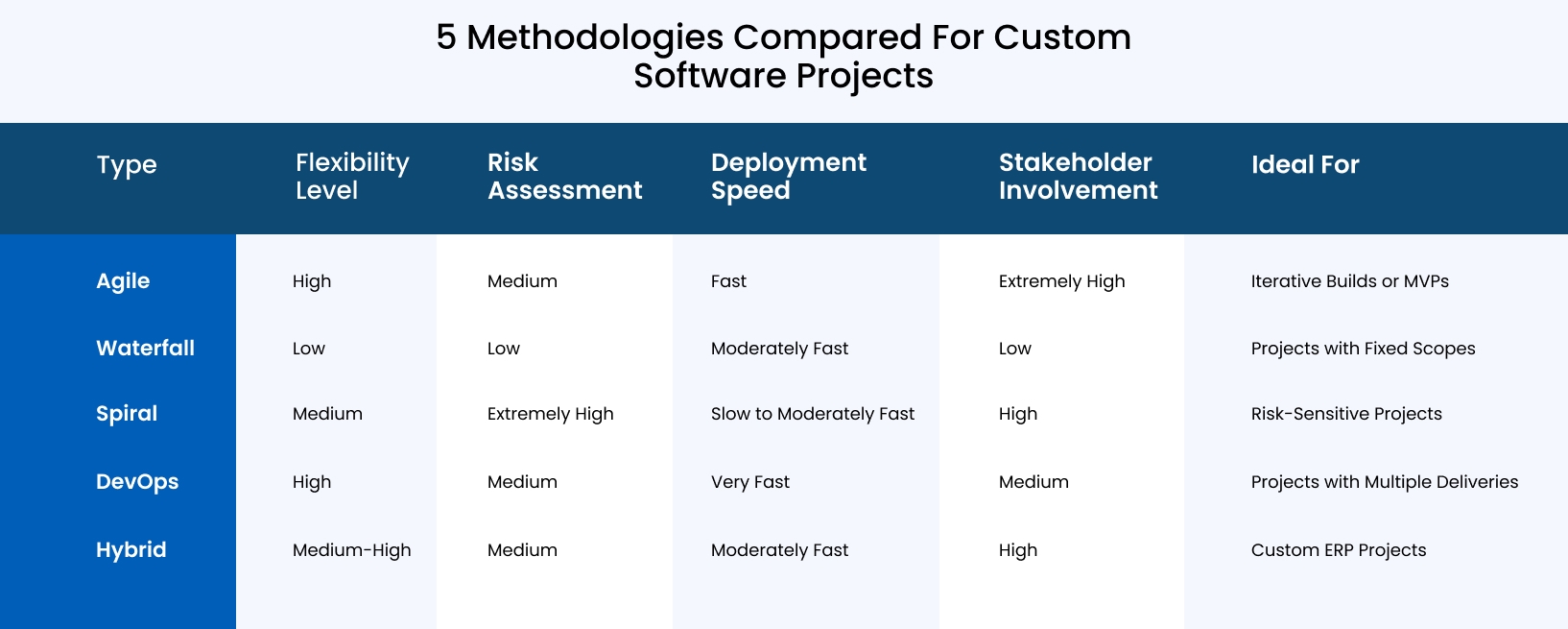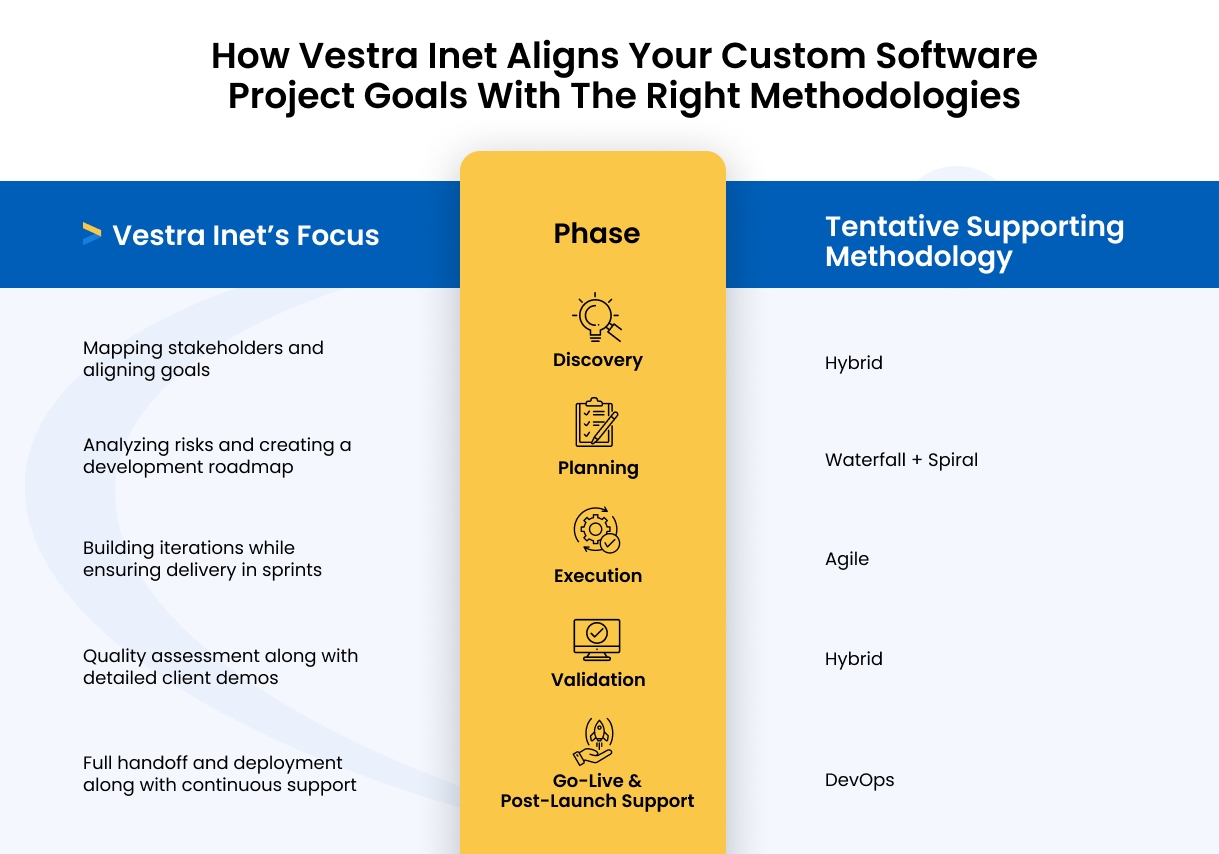A 10-Minute Guide To Choosing A Custom Software Development Methodology

|
Strategies matter. Going into custom software development without a plan is equivalent to setting it up for failure. If misalignment exists between our project’s needs and the approach we take to software development, serious setbacks might follow. Think ballooning budgets, missed deadlines and rounds of rework with no end in sight. It can be a frustrating loop.
The only way out is to break free from ill-suited methodologies and to switch to one that takes project’s flexibilities and nuances into account. We treat our custom software development methodology to be just as tailored as our software.
Choosing the right methodology has a top-down positive impact - it structures development, improves collaboration and communication, and ensures timely delivery. In this 10-minute guide, we will walk you through the most popular methodologies we’ve considered and share our experience in employing them for our custom software development projects.
What Makes Custom Software Projects Unique?
Off-the-shelf solutions are pre-made. You can buy them like a carton of milk off the rack at your local grocery store. Custom software projects are different. No two systems are exactly alike. That is what makes choosing the right custom software development methodology critical. But before we jump to that, you should know what makes custom software unique to gain a deeper understanding of why the right methodology is critical.
High variability in scope and among stakeholders
Most custom software projects start the same - basic requirements form the foundation, which are refined over time. Later-stage requirements can cause a significant shift in the scope of the project. Add multiple stakeholders from different departments to the mix, and you get a cocktail of unique needs and expectations that can make the design process more complex. Methodology can prevent the project from derailing off-course in such cases.
Integration needs and business critical features
Generic software comes with fixed feature sets and integration capabilities. Custom software does not. They often require interfacing with legacy systems or third-party platforms, as well as internal databases. In any case, they are highly likely to include business-critical functions like customer portals, pricing engines and logistic workflows. The methodology you choose should enable phased releases and testing so your day-to-day business operations remain unaffected.
Long-term maintenance and scalability goals
While longevity is a key feature of custom software, so is evolution. It is supposed to be dynamic. It is supposed to grow as your business flourishes and reaches new heights. It is also supposed to be secure and easy to maintain right from the start. That means the methodology you select should make room for future iterations or risk costly rewrites.

Overview Of Leading Custom Software Development Methodologies
“Too many options” is a real conundrum when choosing a software delivery model. But this is a blessing in disguise. It means we can choose a model that offers as close to a custom fit as possible considering our unique software needs. Having a deeper understanding of the most commonly used methodologies, including their strengths, we are happy to share them below.
Agile: Iterative & User-Centric
The name underscores the flexibility that is at the core of the Agile process. It is highly collaborative and relies on frequent feedback. Moreover, it breaks the entire project down into small bursts so a working system can be delivered in short sprints.
If our custom projects have evolving needs and multiple stakeholders, Agile is a great way to manage them all. Especially if business requirements are likely to shift mid-development.
Waterfall: Linear & Predictable
If our custom software projects require maintaining a strict sequence, the Waterfall methodology might work best. It starts with the requirement phase and covers design, implementation and testing finally arriving at deployment.
When our projects have a well-defined scope with minimal room for change, this methodology works well. But flexibility is not its forte. The Waterfall method is all about planning and documenting exceedingly well.
That said, if the debate is between Agile vs Waterfall for custom software projects, we usually analyze the requirements and assess if a mix of the two works best.
Spiral: Risk-Averse & Iterative
Whether our customers are getting a custom ERP or an operations management system, risk is omnipresent. Not necessarily in a terrifying form, but there can be hiccups along the way. The Spiral methodology can help mitigate this with its strong risk-analysis approach. Blending design and prototyping, each cycle of this approach treats planning, risk assessment, development, and evaluation as the foundation.
We consider the Spiral software development methodology when we have highly complex custom projects that tick both the high-risk and high-investment boxes.
DevOps: Fast Deployment & Continuous Feedback
For software projects where speed is the ultimate need, the DevOps methodology is a great option. Combining development and operations, this method ensures fast deployment while promoting continuous monitoring, testing, and integration. Great for custom projects that require quick iterations post-launch.
Hybrid/Agile-Waterfall Blend: Flexible & Easy To Monitor
Sometimes a single methodology is not enough to keep our custom enterprise solution development afloat. In such cases, resorting to a mix of Agile’s adaptability with Waterfall’s structure can be a good fix. For example, our team can use Agile for the execution phase based on the plan laid out by the Waterfall method. It’s an everybody-wins approach that perfectly balances control with responsiveness.

Key Criteria For Selecting The Right Methodology Our Custom Software Projects
Irrespective of the chosen software type - custom ERP or a limited quotation system - settling on the right methodology might take some time and patience. That is precisely because there is no universally best methodology. Finding the ‘best fit’ is what we can do, and that requires a thorough evaluation of the project we have planned.
From the fluidity of the scope to tentative timelines and stakeholder dynamics - every little factor will cumulatively determine the right custom software development methodology for our proposed solution. We have curated a checklist that stacks each methodology against the other to help find the perfect one in the process.
Step 1: Assessing project scope and volatility
When it comes to the project’s scope, it is critical to know if it is still in the evolution stage or if it has been well-defined. We have to consider the possibility of unknowns that may show up during development. Furthermore, the addition of new features based on user or stakeholder feedback should also be taken into account.
We use:
- Spiral or Agile approach if our project scope is continually evolving
- Waterfall or Hybrid software development process if the scope is predefined
Step 2: Evaluating stakeholder involvement and feedback loops
Determining the frequency of stakeholder input, along with the viability of end-users testing early versions helps us select the right methodology.
We use:
- DevOps or Agile if involvement is high
- If stakeholder involvement is low, Waterfall is a good way to go
- Conversely, Hybrid works if stakeholder involvement is necessary for planning but not execution
Step 3: Reviewing timeline constraints and milestone rigors
Having fixed delivery dates requires a different approach from a project that is flexible enough to warrant phased development. We treat the rigidity of the timeline as one of our guiding principles towards methodology selection.
We use:
- Waterfall approach if the timelines are tight
- Agile or DevOps if incremental delivery is possible
- Hybrid software development process if the milestone pressure is high but there is also room for flexibility
Step 4: Considering technical changes and long-term vision
Custom software often tends to evolve after launch. Those changes might be either mission-critical or performance sensitive. Either way, whether the software requires regular updates or scaling, post-launch changes factors into the methodology we settle on.
We use:
- Agile or DevOps if continuous modifications are required
- Spiral if future risks are a concern
- Hybrid if structure and adaptability are must-haves in the long run
Step 5: Factoring in budget flexibility and risk appetite
Budget is a major factor in choosing the right methodology approach. We determine whether the budget is fixed or adjustable and analyze if there is scope for reworks and iterations. We also track if our allocated budget can handle mid-project changes.
We use:
- Agile or Spiral methodology when we are working with a flexible budget
- Waterfall if the budget is tight
- Hybrid if the project’s budget requires monitoring and risk protection
When We Change or Adapt Custom Software Development Methodology Mid-Project
Although rare, it is possible for a custom software methodology to fall short as development progresses. Shifting priorities, unexpected technical challenges or varying stakeholder dynamics can be contributing factors. It is critical to have a flexible mindset to pivot the chosen methodology and save the project from costly reworks and delays.
Red Flags We Watch Out For
These red flags are indicative of a wrong fit, which means our chosen methodology is misaligned and needs to change:
- Scope creep or frequently missed deadlines
- Misinformed or absent stakeholders
- Failure to account for a change of requirements
- Rigid processes that require reworks or slow down project pace
- Frequent miscommunication between teams involved
Signs it is Time to Shift the Approach
Once we have spotted the red flags, we start considering a switch in our custom software development methodology approach. There are additional signs we take into account before making the transition such as:
- Our project requires faster iterations
- We see an increase in stakeholder demands
- Risks crop up demanding tighter control
- Deployment timelines become stricter, requiring a shift
If faster iterations are necessary, moving from the Waterfall to the Agile approach might help. Increased risks require shifting to a Spiral approach, while increased stakeholder demands can be better handled by Agile methodology. In any case, a hybrid software development process is often best when requirements shift.
How Vestra Inet Chooses & Executes The Right Custom Software Development Methodology
Choosing a software delivery model is half the battle won - winning the other half requires executing it with consistency and clarity. For us, every custom software development project is a collaboration that flags off with discovery and goes beyond deployment to cover consistent support.
So whether we are launching an MVP or a mission-critical custom ERP system, our team at Vestra Inet designs the whole process so it goes smoothly both for ourselves and our customers - from selecting the right methodology to development and deployment while balancing agility, clarity and compliance.
Discovery to delivery alignment
At Vestra Inet, a discovery call is not a formality but a way for our team to understand and map stakeholder roles, technical workflows and delivery milestones so we can select the best methodology for the development of their custom software.
Support for both Agile and Hybrid models
We do not shy away from adopting a hybrid software development model because we know that software projects tend to evolve over time. Plus, our team is fluent in iterative delivery, resulting in swift scrums, sprints, and demos alongside the effortless management of complex governance rules. You can be rest assured our hybrid models are both agile and structured.
Experience in regulated, complex environments
Industries such as manufacturing, finance, healthcare, logistics etc. require compliance-driven software, which we are adept at developing. Our deep understanding of industry regulations and compliance standards allow us to adopt creative and flexible iterative development methodologies.

Final Thoughts: Choosing The Right Methodology Is Key
Finding the right iterative development methodology is an essential part of formulating custom software strategies that guarantee success. The methodology we end up choosing will ultimately determine every stage the software we build goes through - from development to deployment.
That is why every software Vestra Inet builds tends to have a smooth production flow, right from the discovery phase. This ensures the entire process is devoid of costly missteps, resulting in a software that scales effortlessly. Contact us to get expertly built custom software today.
FAQs
1. Which is the best methodology for custom software development?
There is no single best methodology. The answer to that depends on your project’s scope, risk tolerance, stakeholder involvement, and complexity. Adopting a hybrid approach can help.
2. Can development methodologies be switched mid-project?
Yes. In fact, it might be necessary if your current methodology leads to unnecessary delays and misalignment. A methodology switch can get your custom software project back on track.
3. Is Agile methodology better than Waterfall for custom builds?
Not always. While Agile is perfect for custom projects with evolving requirements, Waterfall may make more sense for projects that have a fixed scope and tight timelines. The right choice will always be project-dependent.
4. How does methodology impact delivery timelines?
The methodology we choose influences the rate at which features are developed, tested, and deployed. Methods like Agile and DevOps will ensure faster delivery, while Waterfall may increase the timeline but will guarantee fewer unpleasant surprises.
Author Bio
Andrey Wool
Helming the operations at Vestra Inet, Andrey has over 20 years of leadership experience in the ERP industry. Having successfully launched 550+ software projects across a diverse set of industries, Andrey continues to transform the way businesses function with pioneering custom software solutions. His in-depth knowledge of sectors such as manufacturing and distribution has helped him curate actionable solutions that eliminate bottlenecks and pave the way for sustainable growth.
